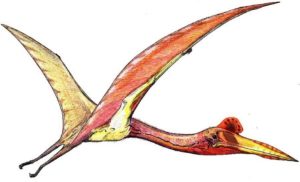Pterosaur, Quetzalcoatlus

Quetzalcoatlus – A brightly colored creature swoops down to land on the branch above. Its head is overly large, with a mouth full of sharp teeth and bright, shiny eyes. The thing chirps, lashes its long thin tail, and then with a flap of leathery wings is in the air once again.
Pterosaurs are often found in regions where dinosaurs and other prehistoric creatures are commonly encountered, yet they are not dinosaurs themselves. The pteranodon is the most well known and widespread of these flying reptiles, but numerous other species exist, such as the relatively small rhamphorhynchus, the venomous dimorphodon, and the lumbering, giraffe-sized quetzalcoatlus. While the larger pterosaurs are awkward f liers, the smaller ones can be quite agile and quick. Pterosaurs generally dwell on coastlines, along rivers, or near swamps or lakes, for the majority of their diet consists of fish snatched from the water in daring dives. Pterosaurs are quite territorial, though, and most won’t hesitate to swoop down and hiss, shriek, and attack things their size or larger.
| Pterosaur, Quetzalcoatlus CR 7 |
| XP 3,200 N Huge animalInit +7; Senses Low-Light Vision, Scent; Perception +13 |
| DEFENSE |
| AC 19, touch 12, flat-footed 15 (+3 Dexterity, +1 Dodge, +7 natural, -2 size) hp 82 (11d8+33) Fort +10, Ref +12, Will +5 |
| OFFENSE |
| Speed 30 ft., Fly 50 ft. (clumsy) Melee bite +13 (2d8+7/x3), 2 wings +8 (1d6+3) Space 15 ft., Reach 15 ft. |
| STATISTICS |
| Strength 25, Dexterity 17, Constitution 17, Intelligence 2, Wisdom 14, Charisma 12 Base Atk +8; CMB +17; CMD 31 Feats Dodge, Flyby Attack, Improved Initiative, Lightning Reflexes, Lunge, Skill Focus (Perception) Skills Fly -6, Perception +13 SQ razor-sharp beak |
| Ecology |
| Environment warm coastline, swamps, or plains Organization solitary, pair, or flock (3-6)Treasure none |
| SPECIAL ABILITIES |
| Razor-Sharp Beak (Ex) A quetzalcoatlus’s razor-sharp beak has a critical modifier of x3. |

Pterosaurs are often found in regions where dinosaurs and other prehistoric creatures are commonly encountered, yet they are not dinosaurs themselves. The pteranodon is the most well known and widespread of these flying reptiles, but numerous other species exist, such as the relatively small rhamphorhynchus, the venomous dimorphodon, and the lumbering, giraffe-sized quetzalcoatlus. While the larger pterosaurs are awkward f liers, the smaller ones can be quite agile and quick. Pterosaurs generally dwell on coastlines, along rivers, or near swamps or lakes, for the majority of their diet consists of fish snatched from the water in daring dives. Pterosaurs are quite territorial, though, and most won’t hesitate to swoop down and hiss, shriek, and attack things their size or larger.
Perhaps the largest of the pterosaurs, the quetzalcoatlus (known to some as the ‘swamp stalker’ and others by the misnomer of ‘dragonling’) is truly an awe-inspiring sight in the air, with its impressive 40-foot wingspan. On the ground, this creature’s profile bears an uncanny resemblance to that of a giraffe, save for the fact that the folded wings arch up to either side of its lightly feathered body, and its head bears a horrific, razor-sharp beak.
Unlike dimorphodons, quetzalcoatluses are difficult to train. Handle Animal checks made to train one of these looming pterosaurs take a -4 penalty.

 Buy me a coffee
Buy me a coffee